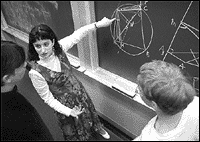Training Math Muscles for the Big Event
Local Students Prepare for Feb. 23 Bay Area Math Olympiad with Help of Campus Mathematicians
By Tamara Keith, Public Affairs
Posted February 17, 1999
 Assistant Professor of Mathematics Zvezdelina Stankova-Frenkel helps David Liu (left), an eleventh grader from Hillsborough and Gariel Carroll, a tenth grader at Oakland Tech, understand a geometry problem. Stankova-Frenkel coordinates the Berkeley Math Circle. Noah Berger photo. |
"We expect to have more than 200 students compete," said Morrey Assistant Professor of Mathematics Zvezdelina Stankova-Frenkel, founder of both the Bay Area Math Olympiad and the Berkeley Math Circle. "There are already 35 schools signed up for the Olympiad, including several schools from Irvine in southern California."
Unlike math clubs, which are usually student run, math circles are led by mathematicians and teachers trained in Olympiad-style problem solving. The Berkeley Math Circle is led by eight mathematicians, five of whom teach at Berkeley. Besides Stankova-Frenkel, they are Alexander Givental, John McCuan, Bjorn Poonen and Vera Serganova.
Participants in the four-hour Bay Area competition, the only regional Olympiad of this type in the western U.S., will be asked to solve and set up proofs for five hard math problems. Four hours may seem like a long time for so few problems, but this is not your average test. Quality over quantity is the philosophy behind it.
"The students have to write complete solutions to the problems," explained Stankova-Frenkel. "If it means they have to include words and explanation, then so be it."
She hopes students who do well in the Bay Area Math Olympiad will go on to compete for a spot on the national team, which she coaches as well.
Math circles like the one at Berkeley are not a new concept, but they are new to California and the United States. First created in Hungary during the 19th century, the circles reached their peak in the former Soviet Union. They are popular all over eastern Europe but are virtually unheard of in America.
When the Berkeley Math Circle started last September, it was the first of its kind in the state. Since then, math circles have sprung up in Oakland, San Jose, Palo Alto and Irvine.
Students in the Berkeley Math Circle range from seventh- to twelfth-graders and come from as far away as Davis and San Jose to participate. Although not restricted to gifted students, the group certainly attracts them. Most participants, having advanced beyond what is available at school, want to increase their math skills and exchange mathematical creativity.
Aaron Wolz, a seventh-grader attending private school in Oakland, says the group enables him to study mathematical concepts that typically aren't available to kids his age.
"In school I'm doing general seventh-grade math. We are currently working on ratios. The math circle is more at my level," said Wolz. "It allows me to explore new areas of mathematics, or at least new areas for me."
Aaron's mother, Laura Wolz, says the math circle is a good outlet for her son's mathematical curiosity. "From the time he was very small, Aaron has always been very interested and talented in math...," said Wolz. "He likes variety in math and he likes playing with math. I thought this would be a way for him to see math from a different point of view."
At the weekly meetings, students tackle difficult mathematical analysis and work on problem-solving techniques. As the problems unfold, an amazing level of difficulty is revealed. The math circle also covers concepts taught in the standard high school curriculum, but presents them differently and at greater depth.
"In our eyes, calculus is by no means the end of the story," said Stankova-Frenkel. "It is only one of the beginnings of many stories. There are many more interesting areas where people do not require so much formal training to start working -- topics like combinatorics, probability, game theory, Euclidean geometry, number theory and algebra."
Stankova-Frenkel hopes that math circles will become more widely accepted and utilized in schools around the country.
"I hope that some teachers will do their own little math circles in high schools, because that is where really they should be," said Stankova-Frenkel. "Math Olympiads need math circles, math circles need Math Olympiads and talented kids need both."
![]()
![]()
February 17 - 23, 1999 (Volume 27, Number 23)
Copyright 1999, The Regents of the University of California.
Produced and maintained by the Office of Public Affairs at UC Berkeley.
Comments? E-mail berkeleyan@pa.urel.berkeley.edu.